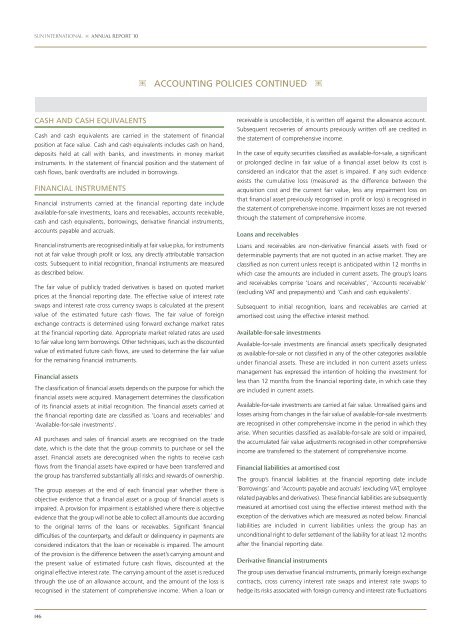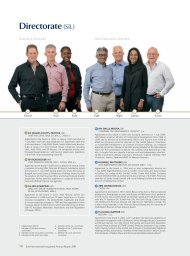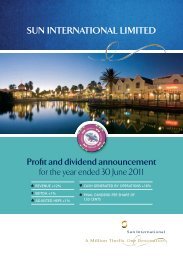PDF 25 MB - Sun International | Investor Centre
PDF 25 MB - Sun International | Investor Centre
PDF 25 MB - Sun International | Investor Centre
Create successful ePaper yourself
Turn your PDF publications into a flip-book with our unique Google optimized e-Paper software.
SUN INTERNATIONAL ANNUAL REPORT ’10<br />
CASH AND CASH EQUIVALENTS<br />
Cash and cash equivalents are carried in the statement of financial<br />
position at face value. Cash and cash equivalents includes cash on hand,<br />
deposits held at call with banks, and investments in money market<br />
instruments. In the statement of financial position and the statement of<br />
cash flows, bank overdrafts are included in borrowings.<br />
FINANCIAL INSTRUMENTS<br />
Financial instruments carried at the financial reporting date include<br />
available-for-sale investments, loans and receivables, accounts receivable,<br />
cash and cash equivalents, borrowings, derivative financial instruments,<br />
accounts payable and accruals.<br />
Financial instruments are recognised initially at fair value plus, for instruments<br />
not at fair value through profit or loss, any directly attributable transaction<br />
costs. Subsequent to initial recognition, financial instruments are measured<br />
as described below.<br />
The fair value of publicly traded derivatives is based on quoted market<br />
prices at the financial reporting date. The effective value of interest rate<br />
swaps and interest rate cross currency swaps is calculated at the present<br />
value of the estimated future cash flows. The fair value of foreign<br />
exchange contracts is determined using forward exchange market rates<br />
at the financial reporting date. Appropriate market related rates are used<br />
to fair value long term borrowings. Other techniques, such as the discounted<br />
value of estimated future cash flows, are used to determine the fair value<br />
for the remaining financial instruments.<br />
Financial assets<br />
The classification of financial assets depends on the purpose for which the<br />
financial assets were acquired. Management determines the classification<br />
of its financial assets at initial recognition. The financial assets carried at<br />
the financial reporting date are classified as ‘Loans and receivables’ and<br />
‘Available-for-sale investments’.<br />
All purchases and sales of financial assets are recognised on the trade<br />
date, which is the date that the group commits to purchase or sell the<br />
asset. Financial assets are derecognised when the rights to receive cash<br />
flows from the financial assets have expired or have been transferred and<br />
the group has transferred substantially all risks and rewards of ownership.<br />
The group assesses at the end of each financial year whether there is<br />
objective evidence that a financial asset or a group of financial assets is<br />
impaired. A provision for impairment is established where there is objective<br />
evidence that the group will not be able to collect all amounts due according<br />
to the original terms of the loans or receivables. Significant financial<br />
difficulties of the counterparty, and default or delinquency in payments are<br />
considered indicators that the loan or receivable is impaired. The amount<br />
of the provision is the difference between the asset’s carrying amount and<br />
the present value of estimated future cash flows, discounted at the<br />
original effective interest rate. The carrying amount of the asset is reduced<br />
through the use of an allowance account, and the amount of the loss is<br />
recognised in the statement of comprehensive income. When a loan or<br />
146<br />
ACCOUNTING POLICIES CONTINUED<br />
receivable is uncollectible, it is written off against the allowance account.<br />
Subsequent recoveries of amounts previously written off are credited in<br />
the statement of comprehensive income.<br />
In the case of equity securities classified as available-for-sale, a significant<br />
or prolonged decline in fair value of a financial asset below its cost is<br />
considered an indicator that the asset is impaired. If any such evidence<br />
exists the cumulative loss (measured as the difference between the<br />
acquisition cost and the current fair value, less any impairment loss on<br />
that financial asset previously recognised in profit or loss) is recognised in<br />
the statement of comprehensive income. Impairment losses are not reversed<br />
through the statement of comprehensive income.<br />
Loans and receivables<br />
Loans and receivables are non-derivative financial assets with fixed or<br />
determinable payments that are not quoted in an active market. They are<br />
classified as non current unless receipt is anticipated within 12 months in<br />
which case the amounts are included in current assets. The group’s loans<br />
and receivables comprise ‘Loans and receivables’, ‘Accounts receivable’<br />
(excluding VAT and prepayments) and ‘Cash and cash equivalents’.<br />
Subsequent to initial recognition, loans and receivables are carried at<br />
amortised cost using the effective interest method.<br />
Available-for-sale investments<br />
Available-for-sale investments are financial assets specifically designated<br />
as available-for-sale or not classified in any of the other categories available<br />
under financial assets. These are included in non current assets unless<br />
management has expressed the intention of holding the investment for<br />
less than 12 months from the financial reporting date, in which case they<br />
are included in current assets.<br />
Available-for-sale investments are carried at fair value. Unrealised gains and<br />
losses arising from changes in the fair value of available-for-sale investments<br />
are recognised in other comprehensive income in the period in which they<br />
arise. When securities classified as available-for-sale are sold or impaired,<br />
the accumulated fair value adjustments recognised in other comprehensive<br />
income are transferred to the statement of comprehensive income.<br />
Financial liabilities at amortised cost<br />
The group’s financial liabilities at the financial reporting date include<br />
‘Borrowings’ and ‘Accounts payable and accruals’ (excluding VAT, employee<br />
related payables and derivatives). These financial liabilities are subsequently<br />
measured at amortised cost using the effective interest method with the<br />
exception of the derivatives which are measured as noted below. Financial<br />
liabilities are included in current liabilities unless the group has an<br />
unconditional right to defer settlement of the liability for at least 12 months<br />
after the financial reporting date.<br />
Derivative financial instruments<br />
The group uses derivative financial instruments, primarily foreign exchange<br />
contracts, cross currency interest rate swaps and interest rate swaps to<br />
hedge its risks associated with foreign currency and interest rate fluctuations










